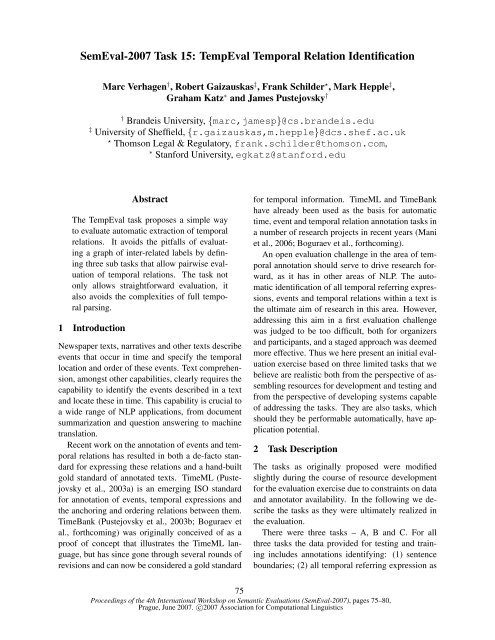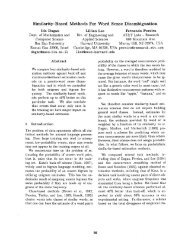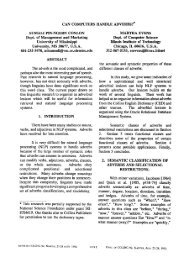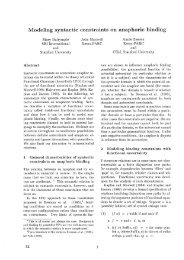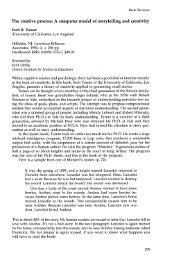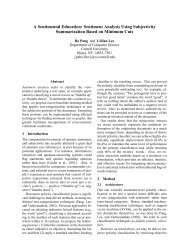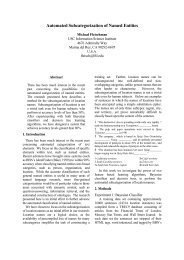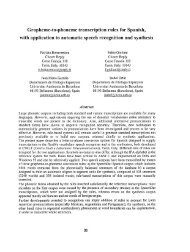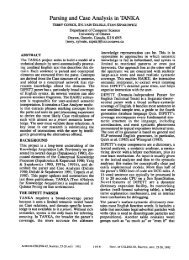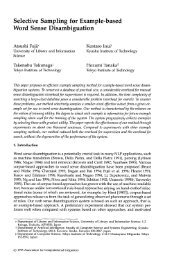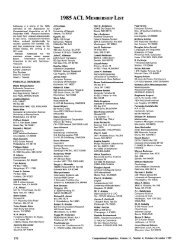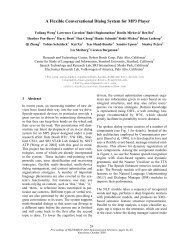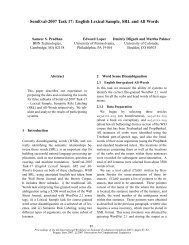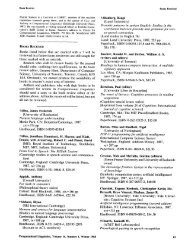SemEval-2007 Task 15: TempEval Temporal Relation Identification
SemEval-2007 Task 15: TempEval Temporal Relation Identification
SemEval-2007 Task 15: TempEval Temporal Relation Identification
You also want an ePaper? Increase the reach of your titles
YUMPU automatically turns print PDFs into web optimized ePapers that Google loves.
<strong>SemEval</strong>-<strong>2007</strong> <strong>Task</strong> <strong>15</strong>: <strong>TempEval</strong> <strong>Temporal</strong> <strong>Relation</strong> <strong>Identification</strong><br />
Marc Verhagen † , Robert Gaizauskas ‡ , Frank Schilder ⋆ , Mark Hepple ‡ ,<br />
Graham Katz ∗ and James Pustejovsky †<br />
† Brandeis University, {marc,jamesp}@cs.brandeis.edu<br />
‡ University of Sheffield, {r.gaizauskas,m.hepple}@dcs.shef.ac.uk<br />
⋆ Thomson Legal & Regulatory, frank.schilder@thomson.com,<br />
∗ Stanford University, egkatz@stanford.edu<br />
Abstract<br />
The <strong>TempEval</strong> task proposes a simple way<br />
to evaluate automatic extraction of temporal<br />
relations. It avoids the pitfalls of evaluating<br />
a graph of inter-related labels by defining<br />
three sub tasks that allow pairwise evaluation<br />
of temporal relations. The task not<br />
only allows straightforward evaluation, it<br />
also avoids the complexities of full temporal<br />
parsing.<br />
1 Introduction<br />
Newspaper texts, narratives and other texts describe<br />
events that occur in time and specify the temporal<br />
location and order of these events. Text comprehension,<br />
amongst other capabilities, clearly requires the<br />
capability to identify the events described in a text<br />
and locate these in time. This capability is crucial to<br />
a wide range of NLP applications, from document<br />
summarization and question answering to machine<br />
translation.<br />
Recent work on the annotation of events and temporal<br />
relations has resulted in both a de-facto standard<br />
for expressing these relations and a hand-built<br />
gold standard of annotated texts. TimeML (Pustejovsky<br />
et al., 2003a) is an emerging ISO standard<br />
for annotation of events, temporal expressions and<br />
the anchoring and ordering relations between them.<br />
TimeBank (Pustejovsky et al., 2003b; Boguraev et<br />
al., forthcoming) was originally conceived of as a<br />
proof of concept that illustrates the TimeML language,<br />
but has since gone through several rounds of<br />
revisions and can now be considered a gold standard<br />
for temporal information. TimeML and TimeBank<br />
have already been used as the basis for automatic<br />
time, event and temporal relation annotation tasks in<br />
a number of research projects in recent years (Mani<br />
et al., 2006; Boguraev et al., forthcoming).<br />
An open evaluation challenge in the area of temporal<br />
annotation should serve to drive research forward,<br />
as it has in other areas of NLP. The automatic<br />
identification of all temporal referring expressions,<br />
events and temporal relations within a text is<br />
the ultimate aim of research in this area. However,<br />
addressing this aim in a first evaluation challenge<br />
was judged to be too difficult, both for organizers<br />
and participants, and a staged approach was deemed<br />
more effective. Thus we here present an initial evaluation<br />
exercise based on three limited tasks that we<br />
believe are realistic both from the perspective of assembling<br />
resources for development and testing and<br />
from the perspective of developing systems capable<br />
of addressing the tasks. They are also tasks, which<br />
should they be performable automatically, have application<br />
potential.<br />
2 <strong>Task</strong> Description<br />
The tasks as originally proposed were modified<br />
slightly during the course of resource development<br />
for the evaluation exercise due to constraints on data<br />
and annotator availability. In the following we describe<br />
the tasks as they were ultimately realized in<br />
the evaluation.<br />
There were three tasks – A, B and C. For all<br />
three tasks the data provided for testing and training<br />
includes annotations identifying: (1) sentence<br />
boundaries; (2) all temporal referring expression as<br />
75<br />
Proceedings of the 4th International Workshop on Semantic Evaluations (<strong>SemEval</strong>-<strong>2007</strong>), pages 75–80,<br />
Prague, June <strong>2007</strong>. c○<strong>2007</strong> Association for Computational Linguistics
specified by TIMEX3; (3) all events as specified<br />
in TimeML; (4) selected instances of temporal relations,<br />
as relevant to the given task. For tasks A and<br />
B a restricted set of event terms were identified –<br />
those whose stems occurred twenty times or more in<br />
TimeBank. This set is referred to as the Event Target<br />
List or ETL.<br />
TASK A This task addresses only the temporal relations<br />
holding between time and event expressions<br />
that occur within the same sentence. Furthermore<br />
only event expressions that occur within the ETL are<br />
considered. In the training and test data, TLINK annotations<br />
for these temporal relations are provided,<br />
the difference being that in the test data the relation<br />
type is withheld. The task is to supply this label.<br />
TASK B This task addresses only the temporal<br />
relations holding between the Document Creation<br />
Time (DCT) and event expressions. Again only<br />
event expressions that occur within the ETL are considered.<br />
As in <strong>Task</strong> A, TLINK annotations for these<br />
temporal relations are provided in both training and<br />
test data, and again the relation type is withheld in<br />
the test data and the task is to supply this label.<br />
TASK C <strong>Task</strong> C relies upon the idea of their being<br />
a main event within a sentence, typically the syntactically<br />
dominant verb. The aim is to assign the<br />
temporal relation between the main events of adjacent<br />
sentences. In both training and test data the<br />
main events are identified (via an attribute in the<br />
event annotation) and TLINKs between these main<br />
events are supplied. As for <strong>Task</strong>s A and B, the task<br />
here is to supply the correct relation label for these<br />
TLINKs.<br />
3 Data Description and Data Preparation<br />
The <strong>TempEval</strong> annotation language is a simplified<br />
version of TimeML 1 . For <strong>TempEval</strong>, we use the following<br />
five tags: <strong>TempEval</strong>, s, TIMEX3, EVENT,<br />
and TLINK. <strong>TempEval</strong> is the document root and s<br />
marks sentence boundaries. All sentence tags in the<br />
<strong>TempEval</strong> data are automatically created using the<br />
Alembic Natural Language processing tools. The<br />
other three tags are discussed here in more detail:<br />
1 See http://www.timeml.org for language specifications<br />
and annotation guidelines<br />
76<br />
• TIMEX3. Tags the time expressions in the text.<br />
It is identical to the TIMEX3 tag in TimeML.<br />
See the TimeML specifications and guidelines<br />
for further details on this tag and its attributes.<br />
Each document has one special TIMEX3 tag,<br />
the Document Creation Time, which is interpreted<br />
as an interval that spans a whole day.<br />
• EVENT. Tags the event expressions in the text.<br />
The interpretation of what an event is is taken<br />
from TimeML where an event is a cover term<br />
for predicates describing situations that happen<br />
or occur as well as some, but not all, stative<br />
predicates. Events can be denoted by verbs,<br />
nouns or adjectives. The <strong>TempEval</strong> event annotation<br />
scheme is somewhat simpler than that<br />
used in TimeML, whose complexity was designed<br />
to handle event expressions that introduced<br />
multiple event instances (consider, e.g.<br />
He taught on Wednesday and Friday). This<br />
complication was not necessary for the <strong>TempEval</strong><br />
data. The most salient attributes encode<br />
tense, aspect, modality and polarity information.<br />
For <strong>TempEval</strong> task C, one extra attribute<br />
is added: mainevent, with possible values<br />
YES and NO.<br />
• TLINK. This is a simplified version of the<br />
TimeML TLINK tag. The relation types for the<br />
TimeML version form a fine-grained set based<br />
on James Allen’s interval logic (Allen, 1983).<br />
For <strong>TempEval</strong>, we use only six relation types<br />
including the three core relations BEFORE, AF-<br />
TER, and OVERLAP, the two less specific relations<br />
BEFORE-OR-OVERLAP and OVERLAP-<br />
OR-AFTER for ambiguous cases, and finally the<br />
relation VAGUE for those cases where no particular<br />
relation can be established.<br />
As stated above the TLINKs of concern for each<br />
task are explicitly included in the training and in the<br />
test data. However, in the latter the relType attribute<br />
of each TLINK is set to UNKNOWN. For each<br />
task the system must replace the UNKNOWN values<br />
with one of the six allowed values listed above.<br />
The EVENT and TIMEX3 annotations were taken<br />
verbatim from TimeBank version 1.2. 2 The annota-<br />
2 TimeBank 1.2 is available for free through the Linguistic<br />
Data Consortium, see http://www.timeml.org for more
tion procedure for TLINK tags involved dual annotation<br />
by seven annotators using a web-based annotation<br />
interface. After this phase, three experienced<br />
annotators looked at all occurrences where two annotators<br />
differed as to what relation type to select<br />
and decided on the best option. For task C, there<br />
was an extra annotation phase where the main events<br />
were marked up. Main events are those events that<br />
are syntactically dominant in the sentences.<br />
It should be noted that annotation of temporal relations<br />
is not an easy task for humans due to rampant<br />
temporal vagueness in natural language. As a<br />
result, inter-annotator agreement scores are well below<br />
the often kicked-around threshold of 90%, both<br />
for the TimeML relation set as well as the <strong>TempEval</strong><br />
relation set. For TimeML temporal links, an interannotator<br />
agreement of 0.77 was reported, where<br />
agreement was measured by the average of precision<br />
and recall. The numbers for <strong>TempEval</strong> are even<br />
lower, with an agreement of 0.72 for anchorings of<br />
events to times (tasks A and B) and an agreement of<br />
0.65 for event orderings (task C). Obviously, numbers<br />
like this temper the expectations for automatic<br />
temporal linking.<br />
The lower number for <strong>TempEval</strong> came a bit as<br />
a surprise because, after all, there were fewer relations<br />
to choose form. However, the <strong>TempEval</strong> annotation<br />
task is different in the sense that it did not<br />
give the annotator the option to ignore certain pairs<br />
of events and made it therefore impossible to skip<br />
hard-to-classify temporal relations.<br />
4 Evaluating <strong>Temporal</strong> <strong>Relation</strong>s<br />
In full temporal annotation, evaluation of temporal<br />
annotation runs into the same issues as evaluation of<br />
anaphora chains: simple pairwise comparisons may<br />
not be the best way to evaluate. In temporal annotation,<br />
for example, one may wonder how the response<br />
in (1) should be evaluated given the key in (2).<br />
(1) {A before B, A before C, B equals C}<br />
(2) {A after B, A after C, B equals C}<br />
Scoring (1) at 0.33 precision misses the interdependence<br />
between the temporal relations. What we<br />
need to compare is not individual judgements but<br />
two partial orders.<br />
details.<br />
77<br />
For <strong>TempEval</strong> however, the tasks are defined in<br />
a such a way that a simple pairwise comparison is<br />
possible since we do not aim to create a full temporal<br />
graph and judgements are made in isolation.<br />
Recall that there are three basic temporal relations<br />
(BEFORE, OVERLAP, and AFTER) as well as three<br />
disjunctions over this set (BEFORE-OR-OVERLAP,<br />
OVERLAP-OR-AFTER and VAGUE). The addition<br />
of these disjunctions raises the question of how to<br />
score a response of, for example, BEFORE given a<br />
key of BEFORE-OR-OVERLAP. We use two scoring<br />
schemes: strict and relaxed. The strict scoring<br />
scheme only counts exact matches as success. For<br />
example, if the key is OVERLAP and the response<br />
BEFORE-OR-OVERLAP than this is counted as failure.<br />
We can use standard definitions of precision<br />
and recall<br />
P recision = Rc/R<br />
Recall = Rc/K<br />
where Rc is number of correct answers in the response,<br />
R the total number of answers in the response,<br />
and K the total number of answers in the<br />
key. For the relaxed scoring scheme, precision and<br />
recall are defined as<br />
P recision = Rcw/R<br />
Recall = Rcw/K<br />
where Rcw reflects the weighted number of correct<br />
answers. A response is not simply counted as 1 (correct)<br />
or 0 (incorrect), but is assigned one of the values<br />
in table 1.<br />
B O A B-O O-A V<br />
B 1 0 0 0.5 0 0.33<br />
O 0 1 0 0.5 0.5 0.33<br />
A 0 0 1 0 0.5 0.33<br />
B-O 0.5 0.5 0 1 0.5 0.67<br />
O-A 0 0.5 0.5 0.5 1 0.67<br />
V 0.33 0.33 0.33 0.67 0.67 1<br />
Table 1: Evaluation weights<br />
This scheme gives partial credit for disjunctions,<br />
but not so much that non-commitment edges out precise<br />
assignments. For example, assigning VAGUE as<br />
the relation type for every temporal relation results<br />
in a precision of 0.33.
5 Participants<br />
Six teams participated in the <strong>TempEval</strong> tasks. Three<br />
of the teams used statistics exclusively, one used a<br />
rule-based system and the other two employed a hybrid<br />
approach. This section gives a short description<br />
of the participating systems.<br />
CU-TMP trained three support vector machine<br />
(SVM) models, one for each task. All models used<br />
the gold-standard TimeBank features for events and<br />
times as well as syntactic features derived from the<br />
text. Additionally, the relation types obtained by<br />
running the task B system on the training data for<br />
<strong>Task</strong> A and <strong>Task</strong> C, were added as a feature to the<br />
two latter systems. A subset of features was selected<br />
using cross-validations on the training data, discarding<br />
features whose removal improved the crossvalidation<br />
F-score. When applied to the test data,<br />
the <strong>Task</strong> B system was run first in order to supply<br />
the necessary features to the <strong>Task</strong> A and <strong>Task</strong> C systems.<br />
LCC-TE automatically identifies temporal referring<br />
expressions, events and temporal relations in<br />
text using a hybrid approach, leveraging various<br />
NLP tools and linguistic resources at LCC. For temporal<br />
expression labeling and normalization, they<br />
used a syntactic pattern matching tool that deploys a<br />
large set of hand-crafted finite state rules. For event<br />
detection, they used a small set of heuristics as well<br />
as a lexicon to determine whether or not a token is<br />
an event, based on the lemma, part of speech and<br />
WordNet senses. For temporal relation discovery,<br />
LCC-TE used a large set of syntactic and semantic<br />
features as input to a machine learning components.<br />
NAIST-japan defined the temporal relation identification<br />
task as a sequence labeling model, in<br />
which the target pairs – a TIMEX3 and an EVENT<br />
– are linearly ordered in the document. For analyzing<br />
the relative positions, they used features from<br />
dependency trees which are obtained from a dependency<br />
parser. The relative position between the target<br />
EVENT and a word in the target TIMEX3 is used<br />
as a feature for a machine learning based relation<br />
identifier. The relative positions between a word in<br />
the target entities and another word are also introduced.<br />
The USFD system uses an off-the-shelf Machine<br />
Learning suite(WEKA), treating the assignment of<br />
78<br />
temporal relations as a simple classification task.<br />
The features used were the ones provided in the<br />
<strong>TempEval</strong> data annotation together with a few features<br />
straightforwardly computed from the document<br />
without any deeper NLP analysis.<br />
WVALI’s approach for discovering intrasentence<br />
temporal relations relies on sentence-level<br />
syntactic tree generation, bottom-up propagation<br />
of the temporal relations between syntactic<br />
constituents, a temporal reasoning mechanism<br />
that relates the two targeted temporal entities to<br />
their closest ancestor and then to each other, and<br />
on conflict resolution heuristics. In establishing<br />
the temporal relation between an event and the<br />
Document Creation Time (DCT), the temporal expressions<br />
directly or indirectly linked to that event<br />
are first analyzed and, if no relation is detected,<br />
the temporal relation with the DCT is propagated<br />
top-down in the syntactic tree. Inter-sentence temporal<br />
relations are discovered by applying several<br />
heuristics and by using statistical data extracted<br />
from the training corpus.<br />
XRCE-T used a rule-based system that relies on<br />
a deep syntactic analyzer that was extended to treat<br />
temporal expressions. <strong>Temporal</strong> processing is integrated<br />
into a more generic tool, a general purpose<br />
linguistic analyzer, and is thus a complement for a<br />
better general purpose text understanding system.<br />
<strong>Temporal</strong> analysis is intertwined with syntacticosemantic<br />
text processing like deep syntactic analysis<br />
and determination of thematic roles. <strong>TempEval</strong>specific<br />
treatment is performed in a post-processing<br />
stage.<br />
6 Results<br />
The results for the six teams are presented in tables<br />
2, 3, and 4.<br />
team strict relaxed<br />
P R F P R F<br />
CU-TMP 0.61 0.61 0.61 0.63 0.63 0.63<br />
LCC-TE 0.59 0.57 0.58 0.61 0.60 0.60<br />
NAIST 0.61 0.61 0.61 0.63 0.63 0.63<br />
USFD* 0.59 0.59 0.59 0.60 0.60 0.60<br />
WVALI 0.62 0.62 0.62 0.64 0.64 0.64<br />
XRCE-T 0.53 0.25 0.34 0.63 0.30 0.41<br />
average 0.59 0.54 0.56 0.62 0.57 0.59<br />
stddev 0.03 0.13 0.10 0.01 0.12 0.08<br />
Table 2: Results for <strong>Task</strong> A
team strict relaxed<br />
P R F P R F<br />
CU-TMP 0.75 0.75 0.75 0.76 0.76 0.76<br />
LCC-TE 0.75 0.71 0.73 0.76 0.72 0.74<br />
NAIST 0.75 0.75 0.75 0.76 0.76 0.76<br />
USFD* 0.73 0.73 0.73 0.74 0.74 0.74<br />
WVALI 0.80 0.80 0.80 0.81 0.81 0.81<br />
XRCE-T 0.78 0.57 0.66 0.84 0.62 0.71<br />
average 0.76 0.72 0.74 0.78 0.74 0.75<br />
stddev 0.03 0.08 0.05 0.03 0.06 0.03<br />
Table 3: Results for <strong>Task</strong> B<br />
team strict relaxed<br />
P R F P R F<br />
CU-TMP 0.54 0.54 0.54 0.58 0.58 0.58<br />
LCC-TE 0.55 0.55 0.55 0.58 0.58 0.58<br />
NAIST 0.49 0.49 0.49 0.53 0.53 0.53<br />
USFD* 0.54 0.54 0.54 0.57 0.57 0.57<br />
WVALI 0.54 0.54 0.54 0.64 0.64 0.64<br />
XRCE-T 0.42 0.42 0.42 0.58 0.58 0.58<br />
average 0.51 0.51 0.51 0.58 0.58 0.58<br />
stddev 0.05 0.05 0.05 0.04 0.04 0.04<br />
Table 4: Results for <strong>Task</strong> C<br />
All tables give precision, recall and f-measure for<br />
both the strict and the relaxed scoring scheme, as<br />
well as averages and standard deviation on the precision,<br />
recall and f-measure numbers. The entry for<br />
USFD is starred because the system developers are<br />
co-organizers of the <strong>TempEval</strong> task. 3<br />
For task A, the f-measure scores range from 0.34<br />
to 0.62 for the strict scheme and from 0.41 to 0.63<br />
for the relaxed scheme. For task B, the scores range<br />
from 0.66 to 0.80 (strict) and 0.71 to 0.81 (relaxed).<br />
Finally, task C scores range from 0.42 to 0.55 (strict)<br />
and from 0.56 to 0.66 (relaxed).<br />
The differences between the systems is not spectacular.<br />
WVALI’s hybrid approach outperforms the<br />
other systems in task B and, using relaxed scoring,<br />
in task C as well. But for task A, the winners barely<br />
edge out the rest of the field. Similarly, for task C<br />
using strict scoring, there is no system that clearly<br />
separates itself from the field.<br />
It should be noted that for task A, and in lesser extent<br />
for task B, the XRCE-T system has recall scores<br />
that are far below all other systems. This seems<br />
mostly due to a choice by the developers to not assign<br />
a temporal relation if the syntactic analyzer did<br />
not find a clear syntactic relation between the two<br />
3 There was a strict separation between people assisting in<br />
the annotation of the evaluation corpus and people involved in<br />
system development.<br />
79<br />
elements that needed to be linked for the <strong>TempEval</strong><br />
task.<br />
7 Conclusion: the Future of <strong>Temporal</strong><br />
Evaluation<br />
The evaluation approach of <strong>TempEval</strong> avoids the interdependencies<br />
that are inherent to a network of<br />
temporal relations, where relations in one part of the<br />
network may constrain relations in any other part of<br />
the network. To accomplish that, <strong>TempEval</strong> deliberately<br />
focused on subtasks of the larger problem of<br />
automatic temporal annotation.<br />
One thing we may want to change to the present<br />
<strong>TempEval</strong> is the definition of task A. Currently, it<br />
instructs to temporally link all events in a sentence<br />
to all time expressions in the same sentence. In the<br />
future we may consider splitting this into two tasks,<br />
where one subtask focuses on those anchorings that<br />
are very local, like ”...White House spokesman Marlin<br />
Fitzwater [said] [late yesterday] that...”. We expect<br />
both inter-annotator agreement and system performance<br />
to be higher on this subtask.<br />
There are two research avenues that loom beyond<br />
the current <strong>TempEval</strong>: (1) definition of other subtasks<br />
with the ultimate goal of establishing a hierarchy<br />
of subtasks ranked on performance of automatic<br />
taggers, and (2) an approach to evaluate entire timelines.<br />
Some other temporal linking tasks that can be<br />
considered are ordering of consecutive events in a<br />
sentence, ordering of events that occur in syntactic<br />
subordination relations, ordering events in coordinations,<br />
and temporal linking of reporting events to<br />
the document creation time. Once enough temporal<br />
links from all these subtasks are added to the entire<br />
temporal graph, it becomes possible to let confidence<br />
scores from the separate subtasks drive a constraint<br />
propagation algorithm as proposed in (Allen,<br />
1983), in effect using high-precision relations to<br />
constrain lower-precision relations elsewhere in the<br />
graph.<br />
With this more complete temporal annotation it<br />
is no longer possible to simply evaluate the entire<br />
graph by scoring pairwise comparisons. Instead<br />
the entire timeline must be evaluated. Initial ideas<br />
regarding this focus on transforming the temporal<br />
graph of a document into a set of partial orders built
around precedence and inclusion relations and then<br />
evaluating each of these partial orders using some<br />
kind of edit distance measure. 4<br />
We hope to have taken the first baby steps with<br />
the three <strong>TempEval</strong> tasks.<br />
8 Acknowledgements<br />
We would like to thank all the people who helped<br />
prepare the data for <strong>TempEval</strong>, listed here in no<br />
particular order: Amber Stubbs, Jessica Littman,<br />
Hongyuan Qiu, Emin Mimaroglu, Emma Barker,<br />
Catherine Havasi, Yonit Boussany, Roser Saurí, and<br />
Anna Rumshisky.<br />
Thanks also to all participants to this new task:<br />
Steven Bethard and James Martin (University of<br />
Colorado at Boulder), Congmin Min, Munirathnam<br />
Srikanth and Abraham Fowler (Language Computer<br />
Corporation), Yuchang Cheng, Masayuki Asahara<br />
and Yuji Matsumoto (Nara Institute of Science<br />
and Technology), Mark Hepple, Andrea Setzer and<br />
Rob Gaizauskas (University of Sheffield), Caroline<br />
Hage`ge and Xavier Tannier (XEROX Research Centre<br />
Europe), and Georgiana Pus¸cas¸u (University of<br />
Wolverhampton and University of Alicante).<br />
Part of the work in this paper was funded by<br />
the DTO/AQUAINT program under grant number<br />
N61339-06-C-0140 and part funded by the EU<br />
VIKEF project (IST- 2002-507173).<br />
References<br />
James Allen. 1983. Maintaining knowledge about<br />
temporal intervals. Communications of the ACM,<br />
26(11):832–843.<br />
Bran Boguraev, James Pustejovsky, Rie Ando, and Marc<br />
Verhagen. forthcoming. Timebank evolution as a<br />
community resource for timeml parsing. Language<br />
Resources and Evaluation.<br />
Inderjeet Mani, Ben Wellner, Marc Verhagen, Chong Min<br />
Lee, and James Pustejovsky. 2006. Machine learning<br />
of temporal relations. In Proceedings of the 44th<br />
Annual Meeting of the Association for Computational<br />
Linguistics, Sydney, Australia. ACL.<br />
James Pustejovsky, José Castaño, Robert Ingria, Roser<br />
Saurí, Robert Gaizauskas, Andrea Setzer, and Graham<br />
Katz. 2003a. TimeML: Robust specification of<br />
4 Edit distance was proposed by Ben Wellner as a way to<br />
evaluate partial orders of precedence relations (personal communication).<br />
80<br />
event and temporal expressions in text. In Proceedings<br />
of the Fifth International Workshop on Computational<br />
Semantics (IWCS-5), Tilburg, January.<br />
James Pustejovsky, Patrick Hanks, Roser Saurí, Andrew<br />
See, Robert Gaizauskas, Andrea Setzer, Dragomir<br />
Radev, Beth Sundheim, David Day, Lisa Ferro, and<br />
Marcia Lazo. 2003b. The TIMEBANK corpus. In<br />
Proceedings of Corpus Linguistics 2003, pages 647–<br />
656, Lancaster, March.


